|
|
 |
Clark County Press, Neillsville, WI May 24, 1995, Page 32 Transcribed by Crystal Wendt & Dolores (Mohr) Kenyon. Index of "Oldies" Articles
|
|
|
 |
Clark County Press, Neillsville, WI May 24, 1995, Page 32 Transcribed by Crystal Wendt & Dolores (Mohr) Kenyon. Index of "Oldies" Articles
|
Good Old Days
| The 14th Wisconsin Volunteer Regiment, Company I | ||
| Noncommissioned Officers | Enlisted | Mustered Out |
| BLAKESLEE, CHAUNCEY First Sergeant, May 6, 62. | Oct. 19, 61 | 29-May-65 |
| MANLY, ANDREW J. First Sergeant, Sept. 2, 62 | Oct. 19, 61 | 22-May-65 |
| STURGEON, Cyrus O. Discharge Sept.22, 62 Re-enlisted Jan. 4, 64 2nd Lt. June 13, 65 | Oct. 16, 61 | Oct. 9, 65 |
| NEVERMAN, WILLIAM Wounded, White River, AR. Corp. Sgt. First Sgt. 2nd Lt. June 13, 65 | Oct. 19, 61 | Oct. 9, 65 |
| ENLISTED MEN | ||
| AYRES, GUSTAVUS R. | Jan. 4, 64 | Oct. 9, 65 |
| BACON, CHARLES G. Wounded Battle of Shiloh: Died Mound City hospital May 7, 62 | Oct. 19, 61 | ** |
| BONE, CHARLES F. Corporal; Wounded; Vicksburg; Discharge with disability July 4, 65 | Oct. 16, 61 | Oct. 9, 65 |
| DARLING, BENJAMIN F. Discharge with disability, Aug. 13, 62 | Oct. 19, 61 | |
| FERGUSON, JAMES W. | Nov. 7, 61 | Oct. 9, 65 |
| GREEN, ALEXANDER Discharged May 30, 62; Re-enlisted Dec. 26, 63; Captured 12, 64; Died at Neillsville, April 13, 65 | Oct. 19, 61 | ** |
| HUTCHINSON, WILLIAM T. | Nov. 7, 61 | Oct. 9, 65 |
| IVES, JOSEPH M. | Nov. 7, 61 | Oct. 9, 65 |
| KING, GEORGE R. | Sept. 3, 64 | 18-Jul-65 |
| LYNCH, LEWIS Died, Rome, GA of disease, July 29, 64 | Dec. 26, 63 | |
| MARSH, STEPHEN Discharge with disability Oct. 18, 62 | Nov. 7, 61 | |
| MEACHAM, ROBERT M. Captured at Corinth, MS; Discharge with disability April 9, 63 | Oct. 29, 61 | |
| NICHOLS, JOHN Discharge with disability, May 20, 62 | Nov. 19, 61 | Oct. 9, 65 |
| O’DANIEL, STEPHEN Wounded, Kennesaw Mountain; Discharged May 29, 65, as wounded | Feb. 6, 64 | |
| O’NEIL, JOHN Died of disease, Paducah, KY | Feb. 10, 62 | |
| OSGOOD, NELSON Died of disease, Natchez, MS, August 27, 63 | Nov. 17, 61 | |
| RHODIUS, JOHN W. | Nov. 11, 61 | Oct. 9, 65 |
| ROSS, HENRY Corporal, Wounded Shiloh; Died of wounds, April 18, 62 | Oct. 19, 61 | |
| SCHLINSOG, GOTTLIEB Killed at Shiloh, April 7, 62 | Nov. 7, 61 | |
| SMITH, DAVID W. Discharged with disability, March 25, 61 | Nov. 6, 61 | |
| STERNITZKY, WILLIAM Corporal; Wounded at Shiloh; Discharged with disability July 24, 62 | Oct. 19, 61 | |
| STURDEVANT, JOHN R. | Dec. 26, 63 | Oct. 9, 65 |
| STUTFRVANT, ROBERT F. Corporal; Sergeant; Discharged with disability, April 2, 62 | Oct. 19, 61 | |
| TAYLOR, GEORGE Discharged with disability, Nov.12, 62 | Oct. 19, 61 | |
¤¤¤¤¤¤¤¤¤¤¤¤¤¤¤¤¤¤¤¤¤¤¤¤¤
By Dee Zimmerman
The American War of the 1860s was referred to as the Civil War; however, it wasn’t as the name implied – two sides fighting for control of the government, but the attempt of one to become a separate nation from the other. It was a clash between two separate communities, the North and the South.
The Civil War (1861-1865) had some distinctive features. It was the largest war in the world at tat point in time. It was also a first in modernization of war – telegraph used in its communications, railroads available for the transportation of troops and supplies, the first duel between ironclad warships, the “Confederate’s Merrimac and the Federals Monitor, as well as the electrically exploded torpedo and sinking of a vessel by a submarine.
In other ways, the Civil War was the last of old-fashioned wars, in which massed armies marched through walls of canister and grape to close in near combat with enemies wielding bayonets, clubbed muskets, and even primitive weapons such as rocks and clubs of wood.
It was referred to as the “singingest war” in American history. Music publishers wrote hundreds of songs to be sung by civilians and soldiers on both sides, a welcome diversion from the wrath of war and hard times. Confederate favorites were: “Lorena,” “Dixie,” “My Maryland,” “Bonnie Blue Flag,” and “Annie Laurie,” while the Northerners, preferred “John Brown’s Body,” “Battle Hymn of the Republic,” “Rally Round the Flag Boys,” and “Pop Goes the Weasel.” Three songs that both sides sang were: “When This Cruel War is Over,” “The Girl I Left Behind Me.” And especially, “Home, Sweet Home.” Today we seldom hear any of these songs. All have fallen along the wayside except for the “Battle Hymn of the Republic.”
The armies of both sides were predominately civilian, since the Regular Army of the country, before secession, number only 16,367 officers and men. The Union force included a considerable number of foreigners, from 20 to 25 percent, mostly German and Irish. Confederate foreigners were less numerous. Soldiers of other races also joined in the ranks.
Keith W. Bennett of Lake Zurich, Ill., recently contributed a manuscript in memoriam to area men who volunteered their services during the Civil War. The following paragraphs are that memoriam.
IN MEMORIAM
By Keith W. Bennett
The telegram to Wisconsin’s governor Alexander Randall was terse, a little desperate.
The United States was in a Civil War. Fort Sumter had fallen to Southern General P. T. Beauregard yesterday, April 14. The capital of the American nation almost cut off from the North. Troops were needed.
A young city, in a young state; Neillsville volunteers had to wait as men jammed recruiting centers all over the state. As the U. S. government raised fresh calls for more men, Wisconsin rushed more new regiments into training.
The chance to serve for the largest Clark County group didn’t come until after a bad Union defeat at Bull Run, July 21, 1861.
Most of the Neillsville men had to get to Fond du Lac, where the 14th Wisconsin was forming. Wisconsin’s flood of volunteers had already filled 13 regiments. Company I of the 14th took the Neillsville volunteers.
Despite an epidemic measles and mumps, a snowy winter in canvas tens, and having to train with some imported muskets, the 14th by early March was ready at the Fond du Lac depot. Each member carried a bundle of meat, bread, butter, cakes, whatever, made up by Fond du Lace Citizens for the 14th’s train ride to Milwaukee.
At Chicago, they marched through the city, were given another supper, and took the trains for Alton, Ill. Then, they boarded steamboats to St. Louis, as General U. S. Grant massed troops for his attach into Tennessee.
On April 17, 1862, the regiment and Company I moved into the bloodbath that was the Battle of Shiloh, worst in the West. It would flood Northern hospitals with wounded, sending a stream of Confederate prisoners up through Cairo, Grant’s base in Illinois.
The 14th heard heavy guns firing, learned that the 18th Wisconsin had already been almost destroyed. Arriving at night, going into the right of the badly shattered Union line, the 14th lay on its muskets in driving rain until dawn. Then the Confederate uniforms came through the trees, but the green troops of the 14th had spiked the guns and burned the artillery cartridges, so the Confederate gunners – even if they recaptured that part of the line – could not use the guns again.
By afternoon, the Confederates lines were breaking. The scratch brigade, thrown together with the 14th Wisconsin, two regiments from Indiana, one from Tennessee, and a battery of Chicago artillery, went in pursuit. Colonel Wood of the 14th was down, Lt. Col. Isaac Westmore was wounded by a shell burst, and Major John Hancock was leading the regiment.
The 14th would lead in the assault on Vicksburg, Miss. Riddled by disease and fighting, the regiment shrank to about 350 veterans. Honored by U. S. Grant, the 14th Wisconsin was chosen to lead the Union troops when they entered Vicksburg, the last Confederate stronghold on the Mississippi River. Grant entered the city July 4, 1863. It was the same day that in the East Meade’s Army of the Potomac won the battle of Gettysburg.
The 14th fought in the Red River Campaign in Louisiana. It was in the White River Campaign to clear Arkansas. Elements of the 14th Wisconsin fought at Mobile Bay in Alabama. Its bullet-riddled battle colors flew in 17 engagements.
Those who remember them on Memorial Day at Neillsville Cemetery also pay tribute to other veterans of the war to save the Union. Buried here are: George Stevens, Co. A, 102nd NY; Alex Olson, Co. G, 5th WI; Nelson Salisbury, Co. B, 22nd WI; W. H. Payson, Co. G, 75th NY; Stephen Weeks, Co. H, 31 WI; Oliver Sanders, Co. L, of a MI Cavalry Regiment; W. F. Thompson, 5th WI Battery; Joseph Brien, Co. D, 42 NY; W. J. Chandler, Co. F, First WI Calvary; Joseph Kopp, 64th IL; Elliott Bliss, Co. I, 15th IL.
Each city in Clark County will be holding Memorial Day services this weekend in honor of those who sacrificed their lives in the wars to preserve our freedoms, let us remember and pay our respects to their memories.
¤¤¤¤¤¤¤¤¤
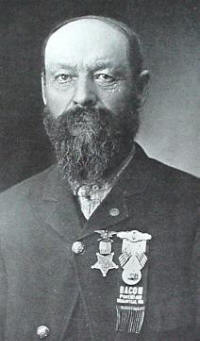 |
George W. Trogner
Trogner enlisted during the Civil War, a member of Company H, 38th Wis. Regiment Volunteers: His regiment joined the Army of the Potomac before Petersburg, Capture of Weldon Railroad, Action of Poplar Grove Church, plus other skirmishes until the war’s end. He settled in Neillsville, took up the carpentry trade and built some beautiful Victorian homes that still grace the city.
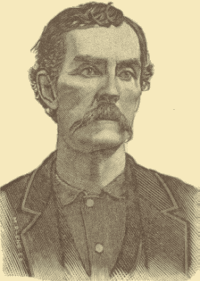 |
Cyril C. Clark
Clark, native of Iowa, at age 21 enlisted in the 7th Ohio regiment an served one year, then in 1861, served one year in the Navy. He came to Wisconsin, after the service, settled in the Town of Thorp.
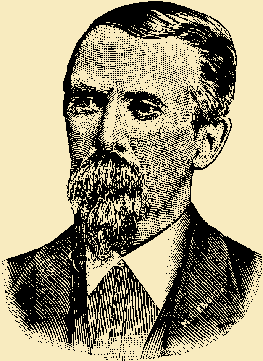 |
Tom B. Philpott
Philpott enlisted, served four years in Co. I, 29th Wis. Inf. After the war, he settled in Loyal where he farmed, served as county sheriff, under sheriff and town offices.
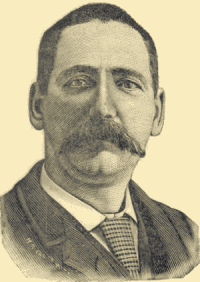 |
C. H. Sheldon
Sheldon served in Co. A, of the 8th Wis. Infantry, one year in the Civil War. He came to Clark Co. in 1882, lived in Thorp, owned a saw mill, then a drug store.
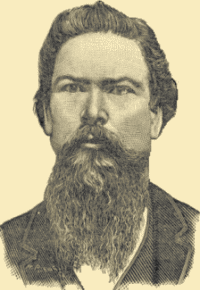 |
H. S. Chase
Chase was a member of the 1st Wis. Cavalry for three years: In 1868, he came to Clark County, farming in the Town of York.
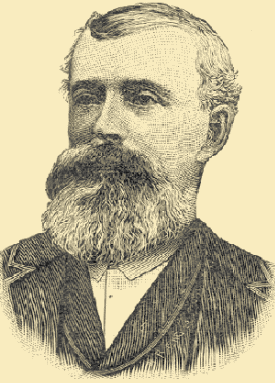 |
A. F. F. Jensen
Jensen enlisted in 1861, served in Co. A of the 6th Wis. Infantry: He came to Dorchester, Clark County in 1873, farmed and ran a general store.
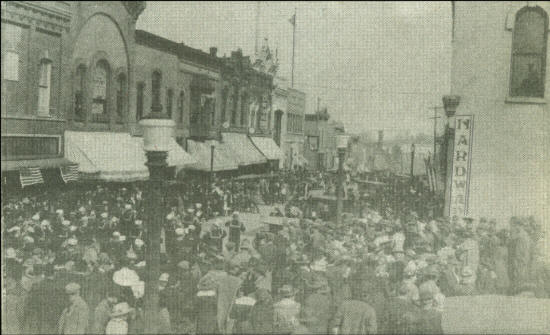 |
It looks like everyone in the city and from many miles around came to Neillsville on this Patriotic Day to observe the parade and celebration. (Photo contributed by Mrs. W. H. Lauer)
•••••••••
The business of life is to go forward. – Samuel Johnson
•••••••••
However brilliant an action it should not be esteemed great unless the result of a great motive. –
Due de La Rochefoucauld
•••••••••••
|
© Every submission is protected by the Digital Millennium Copyright Act of 1998.
Show your appreciation of this freely provided information by not copying it to any other site without our permission.
Become a Clark County History Buff
|
|
A site created and
maintained by the Clark County History Buffs
Webmasters: Leon Konieczny, Tanya Paschke, Janet & Stan Schwarze, James W. Sternitzky,
|